Manual spice grinders: how to choose and use?

The manual spice grinder is a very interesting kitchen attribute. It combines undoubted benefits and aesthetics of appearance, and also indicates high culinary abilities and delicate taste of its owner. And although the product is not a daily necessity, it can often be seen flaunting on a shelf or standing on a housewife's desk.
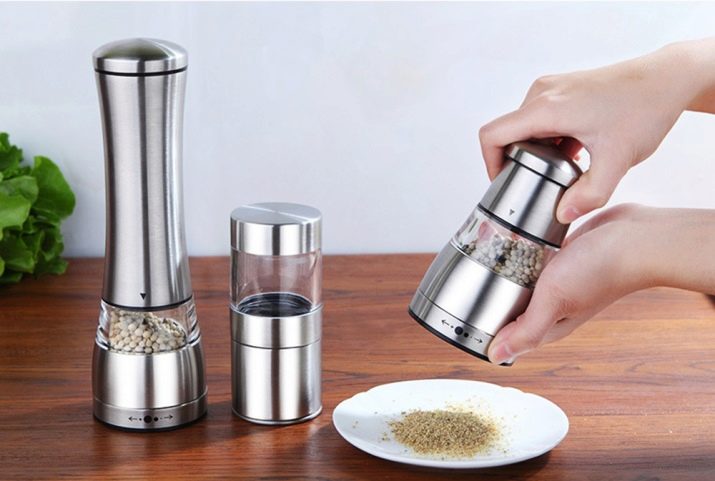
Device and purpose
The design of the mechanical spice grinder is very simple and consists of a robust body, o-rings, handle and millstones. The body, in turn, is divided into two compartments, into one of which raw materials for grinding are poured, and into the second the already crushed product is poured.
The container is often made of transparent materials.allowing you to visually track the amount of spice inside the mill. Inside the case, at the border of two compartments, there are millstones, which are a gear mechanism, when turned, various types of salt, pepper, seasonings and spices are grinded.
The greatest effect is provided by the use of millstones with two rows of teeth, which makes it possible to achieve practically waste-free production and obtain very finely ground raw materials at the output.
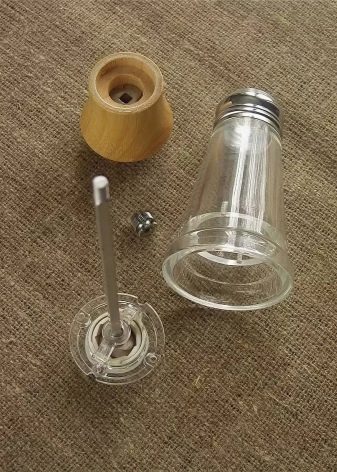
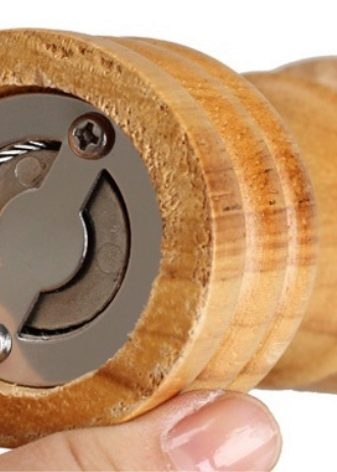
More modern models of mills are equipped with an adjustment function, which is carried out by tightening or loosening a screw on the product cover and allows you to independently select the size of the ground particles. The next design detail is the handle, which not only transmits torque to the millstones and makes them rotate, but is sometimes the main decorative element of the mill.
By their design, handles are remote and built-in... The first is a kind of lever that, like a coffee grinder, rotates over the mill body. The second ones smoothly continue the shape of the body and rotate around their axis, dragging the millstones along with them.
Hand mills are used to finely grind salt, pepper and other spices and herbs directly in the cooking process. This allows you to preserve the indescribable aroma of freshly ground product and give the dish a unique taste. In addition, hand mills are often used as decorative elements of the interior, harmoniously combined with other items.
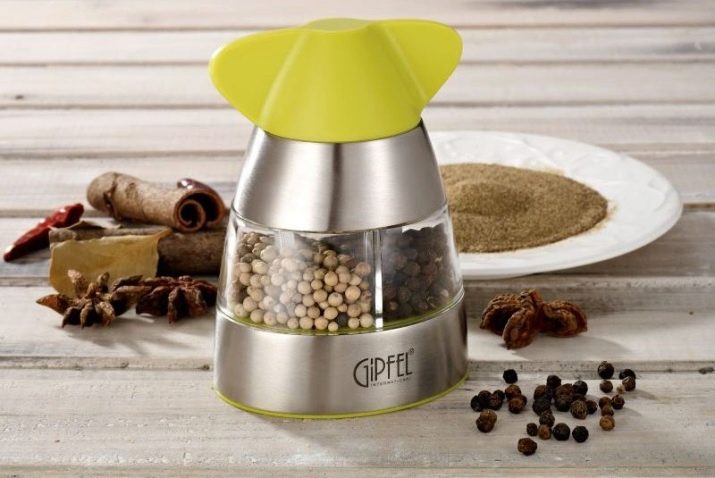
Varieties
The classification of hand mills for grinding spices is made according to several criteria, the main of which is the type of construction. According to this criterion, disposable and reusable models are distinguished, which differ from each other in the maximum service life and price.
- Disposable are a non-separable design and are used exactly until they run out of seasoning. Such products are sold with spices already filled in, and it is not possible to replenish stocks. They rarely exceed 10 cm in height and, with intensive use, empty quite quickly.
After the seasoning inside is over, the mill is thrown away. The advantages of disposable models include the absence of the need to purchase the necessary spices, compact size, simple design and low cost.
The disadvantages include the lack of decorativeness and the need to throw out a hundred rubles every time, which ultimately makes disposable mills an economically unprofitable purchase.


- Reusable the models look much more interesting than their disposable counterparts and are available on the market in a wide variety of sizes and shapes. Among them there are both universal options, designed for grinding any spices, and specialized ones, capable of grinding, for example, only peas.
The former usually have reinforced millstones, additionally reinforced with special knives and can even be used for grinding salt. The latter are designed taking into account the hardness of certain spices and often equipped with a graceful lever handle that decorates the product.
The advantages of reusable mills include the possibility of reusability, increased strength and excellent decorative properties, and the disadvantages - higher, in comparison with disposable models, cost and overall flimsy of the structure.
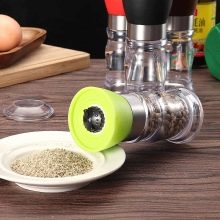

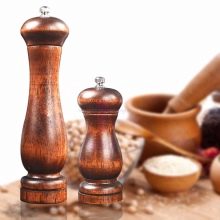
The next sign of the classification of hand mills is the material of manufacture, which is used as plastic, wood and metal.
- Polymer products often have a transparent design and are distinguished by their low weight and low price. However, the millstones in such mills are often made of plastic. Although this reduces the cost of the structure, it does not give it strength and durability.
The most common synthetic material used to make kitchen accessories is acrylic... It is absolutely harmless to human health, does not emit toxic substances upon contact with spices, is beautifully painted in various colors and gives the product a bright and elegant appearance.
Such a mill will not get lost among other kitchen utensils and, in addition to solving practical problems, will serve as an excellent decoration for the kitchen. In addition, plastic mills are odorless and can be perfectly cleaned with warm water and liquid detergent.

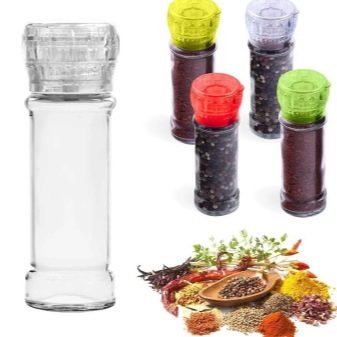
- Wood it is also often used for the manufacture of mills, it gives products a noble and rich look.Such models look very aesthetically pleasing in the kitchen and fit perfectly into most modern interiors. However, wooden mills are more suitable as decorative ornaments than as a daily worker. This is due to the ability of wood to absorb the odors of seasonings, which is why it is customary to use products for grinding only one of them.
This narrow specialization significantly reduces the scope of use of wooden mills and does not allow them to be used as actively as we would like. The body of wooden specimens is often decorated with carving and lacquer coating, and the handle can be both external and built-in.

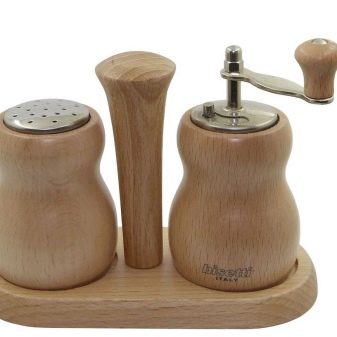
- Stainless steel is an excellent option for making hand mills. In most cases, such models are equipped with metal or ceramic millstones, which guarantees high reliability of the structure and significantly increases the service life of the products.
Metal mills handle even the hardest types of spices perfectly and are also very handy for grinding oily spices.
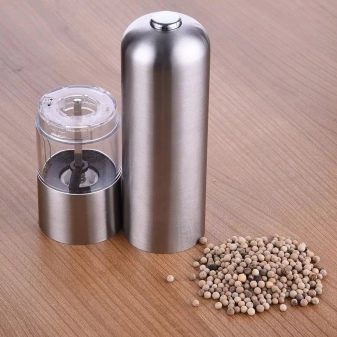

As for millstones, ceramics, stainless steel and plastic are used for their production. The latter can be seen in disposable non-collapsible models, while more durable materials are used for the release of reusable samples.
Criterias of choice
The modern market for kitchen accessories presents a large assortment of mills, so choosing the right product is not difficult. When choosing, it is necessary to take into account parameters such as the material of the body and millstones, the presence of the function of adjusting the degree of grinding and the design of the handle.
So, for constant use, the best option would be a model with metal millstones and a case, which, with careful use and proper care, will last a very long time.
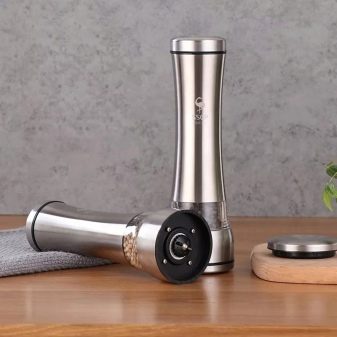
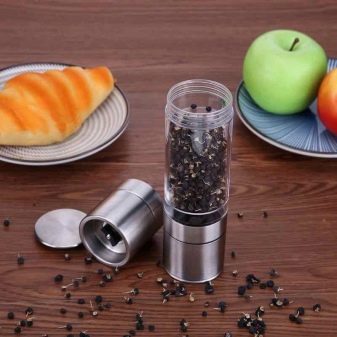
Acrylic products with metal "insides", the same handle and the ability to adjust the grinding have also proven themselves well. The handle often has an outrigger design and chrome finish, which, in combination with the crystal-clear body, looks very stylish and modern. Such products will perfectly fit into any modern interior and will last a long time.
If the mill is chosen as a decorative element, then for classic, ecological, Scandinavian and rustic styles, the wooden model is the best option... It will perfectly fit into the overall look of the room and will be harmoniously combined with other interior items.
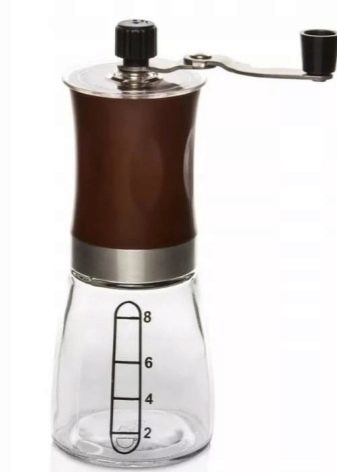
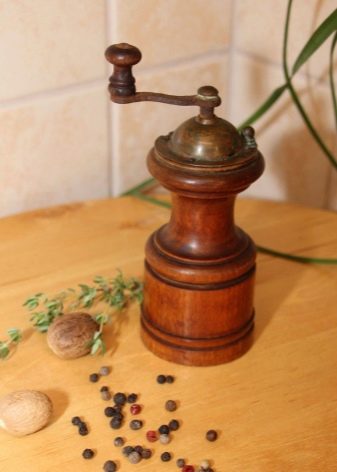
An overview of the budget model of the manual spice mill awaits you further.








